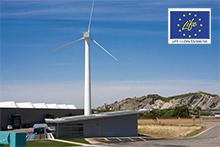 | ||
Factory Microgrid is a demonstrative project cofinanced by the LIFE+ 2013 programme of the European Commission and whose origin can be explained within the framework of the 20-20-20 challenge of the European Union to reduce CO2 emissions and energy consumption. More specifically, it can be framed in theme 1, "Climate Change", and within the line of action "Development of innovative practices for the management of smart grids in the context of highly decentralized production of renewable energy". Its main objective is to demonstrate, through the implementation of a full-scale industrial smartgrid that microgrids can become one of the most suitable solutions for energy generation and management in factories that want to minimize their environmental impact. At a national level it is one of the first experiences regarding the implementation of a smartgrid in an industrial plant with and integrated fleet of electric vehicles. Factory Microgrid will take place between July 2014 and June 2017 and it represents an investment of around 2 million euros. Approximately 50% of the total amount will be financed by the LIFE + programme. Project partners are the Jofemar Corporation and the National Renewable Energy Centre, CENER
Contents
Introduction - Smartgrid
What is a microgrid or a smartgrid? Smart grids are energy networks that can automatically monitor energy flows and adjust to changes in energy supply and demand accordingly. When coupled with smart metering systems, smart grids reach consumers and suppliers by providing information on real-time consumption. Smart grids can also help to better integrate renewable energy.
Specific Aims
Expected results
Main environmental benefits
About LIFE
The LIFE program programme is the EU's funding instrument for the environment. The general objective of LIFE is to contribute to the implementation, updating and development of EU environmental policy and legislation by co-financing pilot or demonstration projects with European added value
